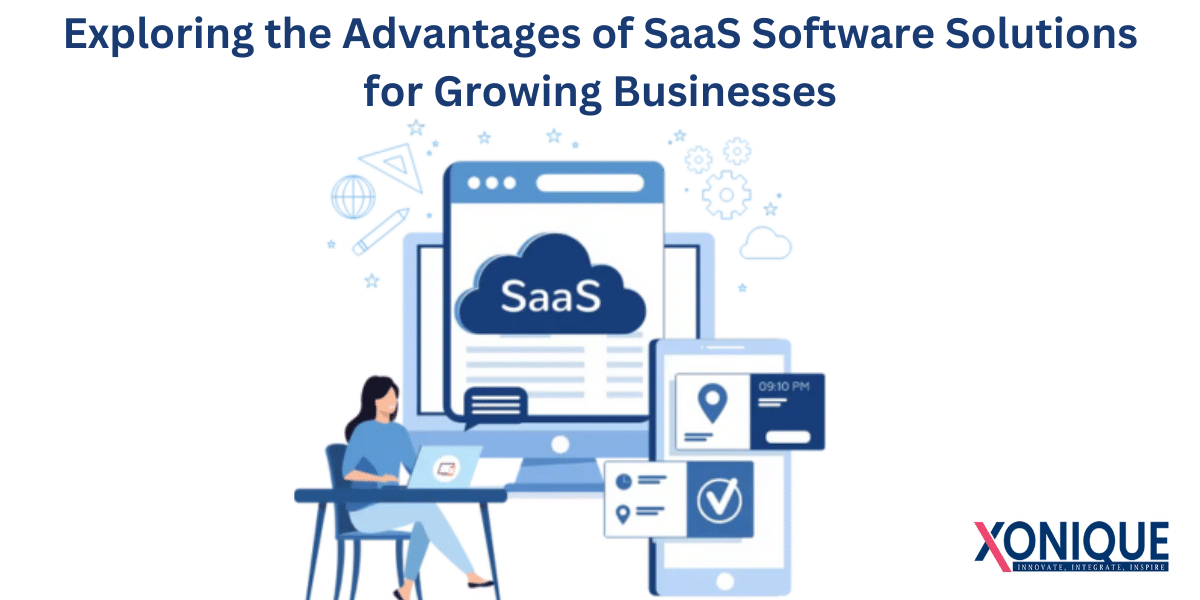Have you ever thought about what SaaS refers to? “Software as a Service” is a distribution method for applications that lets cloud-based providers host applications and then make them accessible for users to download them on the web. The growth of SaaS adoption has occurred quickly in the past decade, mainly in the non-IT business. With cloud services (pun intended) and the explosion, we’re close to the tipping point, where SaaS-aided designing (CAD) and PML applications can give on-premise apps an uphill battle!
SaaS and other trends in enterprise software development have become a buzzword that could be clearer and easier to keep in mind. This software delivery method provides you with the most up-to-date technological advancements within a budget you have set. Ultimately, professional assistance cloud computing or SaaS allows your company to get the most value from your expenses and is highly adaptable.
In this blog, we will explore the advantages of SaaS Development Services for businesses to grow. Also, study why SaaS is the next frontier for enterprise and why you’d like to be one of the pioneers in that new future.
What Is SaaS?
SaaS refers to “software as a service.” It’s a software that lets users connect to and utilize applications on the Internet. If you’ve ever viewed the latest movie on Netflix, made a call using Zoom, or even utilized Google Docs, Dropbox, or iCloud, you’ve been using SaaS software.
In contrast to traditional software applications, SaaS applications don’t need to be installed on your system. They are also generally less costly because you only pay for the required features. The main benefit of SaaS apps is that they can be used anywhere worldwide, as long as there’s internet access. This is why SaaS is considered one of the critical technologies to the success of any enterprise, assisting the employees and executives in achieving their objectives in a matter of minutes.
Differences Between SaaS Platforms and On-Premise Software
Most traditional on-premise applications are bought with a usage license, which is paid for the whole bundle upfront. Most software licenses are restricted to only one person or device depending on whether the software is included with hardware or considered a standalone purchase. The customer must pay the fee once to begin using the conventional software. After that, he can continue using the program by installing it onto his device.
In contrast, a SaaS Software Development Company permits users and companies to join the service monthly or annually without spending large amounts of cash on licensing charges. SaaS offers a significant advantage over conventional software delivery methods: a business or the user can end their subscription whenever it is no longer required. This option protects companies and users from long-term contracts and licensing issues. Because SaaS runs on the cloud and apps are constantly updated on the cloud. This results in the company or the user saving resources that could have been dedicated to updating every device.
The SaaS platform is an alternative to the traditional model of buying software. Nevertheless, it offers significant advantages for businesses that use it. As the use of cloud computing gains speed, software vendors worldwide have begun to add SaaS features to their product portfolios, bringing significant benefits when companies adopt this service.
Benefits Of SaaS Solutions To Grow Your Business
It is possible to reap many benefits by moving your IT infrastructure to the cloud. In discussing the benefits of SaaS software, the first important thing to consider is that it will lower your expenses. Let’s look at the advantages of SaaS that can benefit your company.
You Always Have The Latest Updates And Features
One of the problems that business owners have to confront when purchasing software is that it requires frequent, lengthy, and costly updates. Updates can cost a lot, so money should be invested in software upgrades that can be utilized elsewhere. If necessary software updates are done, your business may be fine.
It’s also common to add features as software updates become available. This is a typical method to attract new customers and motivate existing customers to purchase the upgrade. It is essential to be aware that software-related bugs are standard; therefore, regular software updates that consume staff members’ time are required to avoid problems related to the bugs. However, SaaS users always have the most recent software versions and can enjoy the latest capabilities without spending more.
Many business owners can quickly discover the latest features that allow their staff to perform better and generate more profits. Likely. The new technology may improve data accessibility or help with daily tasks, and more efficiently, it’s justifiable.
Cost-Effective
Selecting SaaS will result in huge savings due to several factors. First, SaaS eliminates the upfront expenses users must cover for purchase and installation. In addition, ongoing costs such as maintenance and updates also are eliminated. Instead of spending vast amounts of cash on hardware, SaaS apps are easily downloaded and practically maintenance-free from the users’ end.
The pay-as-you-go SaaS pricing system also allows companies to lower costs because they will only purchase the software they utilize and don’t waste money on unneeded licensing. For smaller businesses, SaaS is an excellent benefit because these companies can now access high-performance software that’s not costly. Still, it is not available with traditional purchasing methods because of financial constraints. A subscription-based approach to SaaS platforms removes the economic risks from expensive software.
SaaS is a model of deployment that takes care of IT infrastructure issues and can deploy enterprise applications without the need for time and energy-intensive hardware maintenance. This is the sole responsibility of the SaaS supplier, which allows companies to pick the best OS to free up resources and redirect these resources to different processes.
Improved Collaboration
Collaboration is crucial to the growth of any company. Eighty-six percent of employees and executives report that lack of cooperation leads to failure in the workplace. That’s where SaaS platforms are a shining example. With services like GitHub or GitLab, you can collaborate in the same area alongside your colleagues worldwide, and everyone works in the same room.
Collaboration includes chatting with team members through audio or video calls. It allows you to talk without ever leaving your office (or any other place you may be). Nearly every SaaS platform has built-in video and chat capabilities, allowing stakeholders to communicate efficiently.
Your Data Is Safer
In the past, many firms kept all their information locally. Although this was generally effective, it is, at most, risky. In a natural disaster or fire, the data becomes deleted and not recoverable. If an enterprise had backups stored off-site, recovering most of the information was feasible. However, the cost of that storage was high.
Benefits of SaaS companies’ Cloud-based storage platforms remove the obligation to back the company using them. The risks of losing data are minimal, and backups are kept regularly, so your business security is always in place. In addition, workers can change between their devices and move between locations without the stress of accessing ongoing projects. When using SaaS, your data is available from any approved device.
Increased Scalability And Flexibility
In terms of the advantages of SaaS, how would you like to quickly expand or reduce your capacity to adapt to the evolving demands of your business? Without having to make significant upfront investments in software or hardware. This flexibility is advantageous for rapidly expanding companies because they can quickly include new features and users when needed.
Customized SaaS Solutions can be more straightforward to install than on-premise solutions. This means that businesses can start up efficiently and quickly with little interruption. benefits of SaaS platforms can save businesses both time and cash; for instance, expanding storage capacity by increasing SaaS capacity is easily possible. It contrasts traditional software, which requires you to purchase and install the latest software licenses. As SaaS applications can be rapidly updated and upgraded when new features are made accessible, users can keep updated with technological developments.
High Compatibility
The traditional way of installing software and updating takes a long time and can be costly. Problems with compatibility can result because of differences in versions between the workers. With SaaS software, clients can log in to the most updated version of the SaaS solution. It’s the SaaS vendor’s responsibility to oversee the updates and upgrades. This eliminates the requirement to install patches.
SaaS ensures that users can always access the most current version of software. The definition of software as a Service is a way to eliminate issues like software maintenance or incompatibility, thereby providing your business with more efficient focus and increased efficiency.
Things Are Simpler For Business Owners And Customers
SaaS gives business owners an abundance of options. Whatever the nature of the business you run, the software may easily be tailored to fit the specific requirements of your business. The company’s culture can also influence the software used in the workplace since everyone needs to feel comfortable using the program and utilize the software effectively.
The customer experience is also crucial. If the customer can’t easily make a payment for their purchase, they’ll quickly go to the competitor’s website. Businesses must also demonstrate the ability to accept payments from different nations. Leading payment companies allow businesses with clients to receive payment from almost any part of the world. It makes it a lot more straightforward for companies to grow.
Monitoring your business’s performance is simpler if a central, cloud-based software is being used. Most big SaaS companies collect information and provide that data to their customers. This means you’ll know what areas in your business perform poorly and possess the necessary information to decide on future actions.
Boosted Efficiency Through Automation
Imagine an industry or any other sector — and be confident that this sector will gain by SaaS. Most companies currently use SaaS solutions and regularly reap the advantages of SaaS. SaaS platforms are generally simple to utilize and enable companies to access their information whenever, anywhere, providing incredible effectiveness. Don’t bother installing software or purchasing equipment. Users will take care of everything with SaaS solutions. Most SaaS platforms offer built-in functions and integrations to help companies automate their tasks and workflows.
Automating routine tasks can effectively increase efficiency, cut the time needed to perform typically manual tasks, and reduce errors. The most skilled employees manually enter or retrieve data, jumping between tasks and taking up around forty percent of work time. And what’s more alarming is that 54% of employees in the workplace are more likely to be searching for documents and files rather than working.
Effortless Integrations
If you attempt to conduct every kind of software test on the applications you must incorporate to find out how they interact, You’ll not only waste time and money, but you’ll most likely get bored, too. We’re now at another benefit of SaaS! If you’re searching for an application that can integrate with other software and systems, consider a SaaS alternative. SaaS apps are easily integrated with other programs, making them ideal for organizations.
A SaaS application could be effortlessly linked to the above programs if you utilize an accounting application, a CRM program, and a tool for managing projects. In this way, you’ll get rid of the headache of dealing with multiple software applications that don’t communicate with each other. Additionally, SaaS applications typically run on the cloud, which means they are accessible anywhere with Internet connectivity. Therefore, even if you’ve employees who work from home or frequently travel and are often on the move, they can use the applications they require. Ultimately, SaaS is an excellent alternative if you’re searching for software that fits perfectly with the existing configuration.
Find New Users As Your Company Grows
One of the most significant advantages of SaaS is the ability to scale. For a startup, a company’s requirements differ from those of an established large company. A well-established company already has a customer base and is aware of the demands of their clients. Startups could have a pretty good idea of their target demographic; however, that information still needs to be validated.
What’s essential to a company is to identify the customers they may be able to attract and formulate strategies for marketing to this particular group. While doing so, information from the SaaS company allows them to adjust their plan when they expand.
Knowing this means that you will have fewer mistakes made today as well in the future, which means profits could be increased without wasting either time or money throughout the process. Additionally, operating costs can be reduced when employees have all the knowledge they need to operate effectively. This doesn’t mean that traditional companies can’t benefit from SaaS. It is accurate; however, the required data could differ significantly from the startup’s. The details become more crucial, and the data available with SaaS makes it easy for companies to identify patterns that could or might be detrimental to the performance.
Regardless of their experience, any company should be able to adapt and discover new methods of improving their business. Today’s competition is intense, and not recognizing the need to adjust will cost you. Even though SaaS is one of many options for being aware of technological advancements, it’s essential.
Are Your Business Prepared For A SaaS Platform?
If you want to use cloud technology, your organization is unsuitable for SaaS. However, if you’ve got great software, a reliable client base, and a reliable payment processor, you’re on your path to adopting this SaaS model. The SaaS platform is an ideal business model for clients and software vendors if they use it properly. It is a user-friendly service for your customers while permitting your company to enhance your product and easily convey these changes to clients. If you’re looking to increase the efficiency of your company and elevate your business to the next level, SaaS is a suitable option.
The Challenges Of SaaS Software Implementation
Developing SaaS software is a minor deal; however, knowing the steps is crucial. Below is a list of the most frequent issues SaaS software development poses, some resulting from SaaS drawbacks.
Integration Into Existing Systems
To succeed in SaaS application development, it is essential to integrate all the apps that small and mid-sized companies are likely to use. Including your apps from the beginning with a few alternatives is necessary. Having available API connectors to meet standard integration requirements is recommended.
Security Issues
Security is a crucial aspect of SaaS since any device could be an attack source. Ensuring you have a secure solution, with the security features put in place and up to date, is essential.
Data Migration
Moving large volumes of data onto a new SaaS platform requires time and careful planning to avoid disrupting business operations. It’s only accessible with the knowledge of enterprise-grade data transfer. You’ll likely need your clients to be empowered by providing data migration solutions.
Rely Heavily On The Internet Connection
Cloud hosting is one of the most significant benefits and drawbacks of SaaS. The client is responsible for ensuring uninterrupted uplink and backup accessibility. At the same time, it’s essential to have the possibility of failover to ensure minimal disruption if the connection goes down. This is just the top of the list; every project will have unique challenges depending on the existing tools, processes, business plan, and budget. This is why joining forces with an agency for web development with a track record of success can be a practical choice.
Let’s Conclude
SaaS solutions provide a variety of advantages to modern businesses that contribute to their overall growth. Through SaaS, business owners can gain access to and access software programs without needing to pay costly hardware, infrastructure, or even licensing costs. SaaS Software Solutions are simple to set up, highly adaptable, and suitable for companies of any size. They also encourage collaboration, which is essential in the current work world. SaaS companies invest heavily in security to ensure that customers’ information is secure. SaaS providers take responsibility for keeping and updating software while businesses focus on running their core business tasks. SaaS solutions offer significant advantages to modern companies and are integral to the ever-changing technological landscape.











